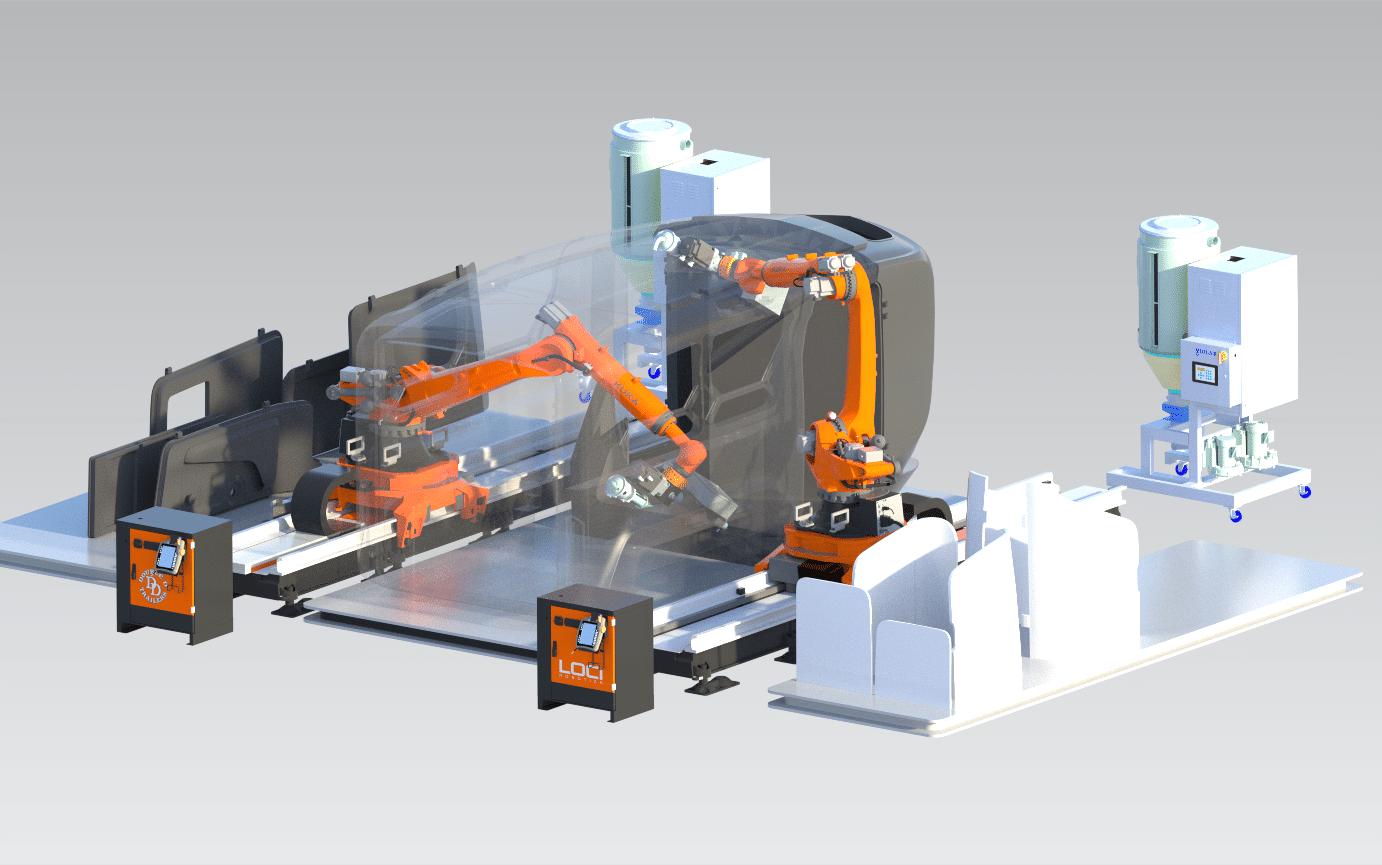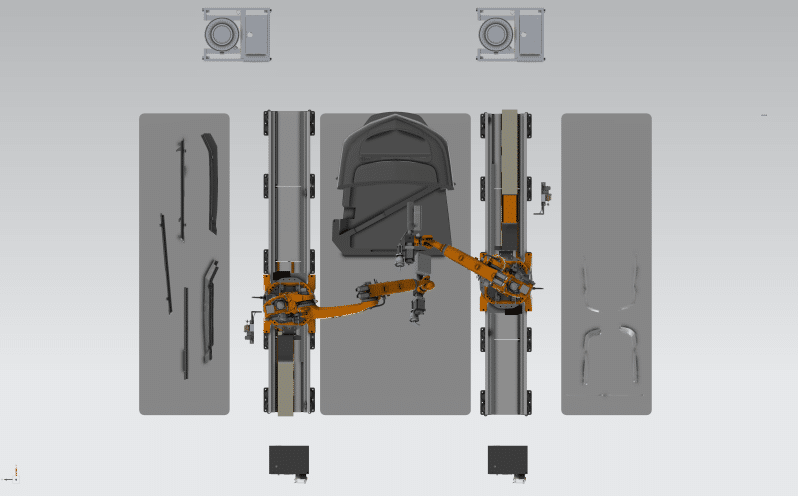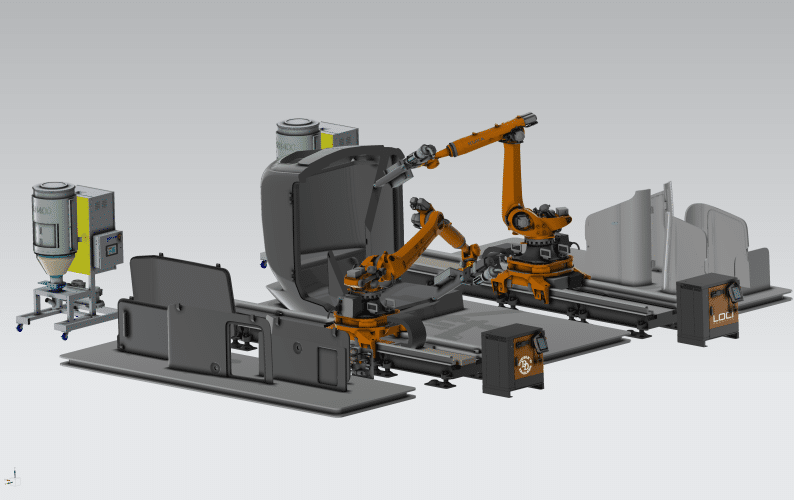Learn All About Horse Trailer 3D Printing Manufacturing
Horse trailer 3D printing manufacturing is a relatively new technology, so we are working closely with experts who know far more about the world of 3D printing manufacturing than we do. Our team of designers at ONE/ONE Lab and engineers at Loci Robotics have assisted us with every step of the process. This ensures that the process of horse trailer 3D printing manufacturing results in the production of an innovative and safe horse trailer.
We spoke with the CTO and Co-Founder of Loci Robotics, Jeff Foote, who answered some questions for us and gave us more insight into the world of 3D printing manufacturing.

Loci Robotics visually demonstrates the process of constructing the first 3D-printed horse trailer.
A Background of 3D Printing Manufacturing
Large scale polymer 3D printing began around 2014. Local Motors in conjunction with Oak Ridge National labs, and the Cincinnati Machine Company co-developed the Big Area Additive Manufacturing (BAAM) system and successfully printed a driveable car at the 2014 IMTS show in Chicago. Cincinnati went on to further develop and commercialize the machine, while ORNL and LM focused on material research and product development. Material suppliers quickly got involved, and have since developed specific formulations of polymers to improve print quality and strength. Since 2014, Thermwood, Ingersoll, and a few smaller companies have produced competing machines, all in a large gantry format.
Within the past few years, a number of smaller companies have begun producing printers based on industrial robotic arms. These printers offer advantages of lower cost, smaller required footprint, lower energy requirements, and a much more flexible approach to printing, as the extruder can be oriented anywhere in space.
What Type of 3D Printer is Capable of Printing a Project This Big?
Printing something as large and complex as the Double D horse trailer requires a uniquely capable printer system. A typical gantry style printer would struggle to print the trailer due to the many internal and external features of the trailer. A robotic based system has many advantages in this case, as the extruder itself can be oriented at the most advantageous angle for each feature of the trailer. By mounting a robot on a linear rail, you can print longer trailers, and by mounting two robots side by side, you can print wider and faster. Robots create a very flexible system that can be tailored to the specific requirements of 3D printing horse trailers.
How Does the 3D Printer Work?
There are two major components to a robotic 3D polymer printer: the robotic arm, and the extruder. The arm is responsible for positioning the extruder and moving it precisely through a computer driven path, and accuracies of plus or minus 0.002 inches. The extruder melts and deposits the polymer at a precise rate along the defined path, so that the exact wall thickness and layer height is achieved, even over very complex designs.
Additive Manufacturing in 3D Printing Technology
Additive manufacturing provides distinct advantages when designing new structural components, but it does also require designers to learn some new rules. A 3D-printed vehicle should NOT look like a traditional sheet metal vehicle, as that would not take full advantage of the technology. Additive allows you to place material (and by extension strength and stiffness) exactly where it needs to be, leading to quite unique designs, and ultimately unique final products. This uniqueness certainly shows up in the Double D Trailers 3D-printed trailer.
Thanks again to Jeff Foote for his knowledgable feedback and insight into how manufacturing a 3D-printed horse trailer will work!
Specs on the 3D-Printed Horse Trailer Created with 3D Printing Manufacturing

What is the ground clearance of the 3D-printed horse trailer?
Most bumper pulls in the US average around 12” from the bottom of the frame to the ground. However, the axle tube on all bumper pulls is lower than that. The Carbon series will be no different than our current conventional builds as far as clearance.
What is the weight of the 3D-printed horse trailer?
25% less than current build methods. A standard forward facing bumper pull in the Carbon printed series will be around 2,500 lbs. The Safetack Reverse Carbon which will be a Warmblood size and reverse load will be approximately 3,800 lbs. For comparison, the same layout in Z-Frame is 5,100 so the carbon will be a significant weight savings.
What is the length/width of the 3D-printed trailer?
15 -16 feet in length depending on the horse size. Width is a full 96” box width so a 17.2 Warmblood will have ample room to lower their head while traveling which allows them to cough, clearing any dust and debris.
How many horses will fit in the 3D-printed horse trailer model?
Our first trailer model to be 3D-printed, the SafeTack Reverse 2 Horse Bumper Pull Carbon, will accommodate 2 Warmbloods up to 17.2 hands
What about the accessories on the 3D-printed horse trailer?
Tie rings will be entirely different compared to current build methods. The only option in the industry is to have a bolt-on or weld-on tie loop in a specific location. There is no adjustment on the placement of the loops. In addition, bolt or weld styles must attach to a structural upright whether it’s an inside tie, or an outside tie. The Safetack Reverse Carbon series will have the ability to locate ties in any position along the interior wall and exterior wall of the trailer. There will be two ties per horse inside (four per stall since it’s reverse load two per end) and four ties exterior, two per side. If a handler wishes to add additional ties, it’s easy to do so…simply attach to the track and slide the tie to the desired location. No bolts or mechanical fasteners needed.
How many windows are on the 3D-printed horse trailer, and where are they located?
Currently the plan is to install a moonroof in the front dressing room for ample light. In the horse area, it’s a huge piece without any window frames or obstructions of 3D-printed translucent material. It has the ability to withstand someone trying to break it with a hammer so durability will not be a factor. The lift wing style windows will allow more light in the trailer than any other trailer on the market. They even curve around and hinge on the roof for even more light. There will be ample glass on both sides of the trailer and back door.
For comparison, we currently use one of the largest windows in the industry which are 24” x 30” size fold down. The reverse load has these on both ends so you have 5 square feet per stall, per end, or 10 square feet per stall. A 2 horse will have 20 square feet of glass and 3 square feet in the back door. Total window space 23 square feet.
The Safetack Reverse Carbon will have approximately 69 square feet of glass in the horse area, unobstructed. It’s a legitimate game changer on the amount of light that can enter the trailer especially with a small portion coming from the roof curve.
Is the patented SafeTack Reverse available on the 3D-printed trailer model?
The SafeTack Reverse layout will be standard on the 3D-printed trailer. Another improvement will be an easily removable safetack compartment. This will allow handlers to haul larger things (other than horses) such as a golf cart.
What about SafeKick Wall Technology or Rumber flooring?
With 3D, there isn’t any need to add anything to the sidewalls of the trailer for durability as the material itself will be the wall. Rumber flooring will not be an option since the entire bottom portion of the trailer will be printed in carbon fiber. The horse flooring will have a traction surface or a rubber mat, easy to clean.
What type of ramps are available on the 3D trailer?
Slide-in ramps will be standard on all models in an enclosed compartment underneath. This means you can use the ramp, or use it as a step up without making any changes.
Combining Horse Trailers with the World of 3D Printing Manufacturing
3D printing manufacturing has evolved in many ways, just in the past few years. With the expansions in the industry and the technology becoming more readily available, Double D Trailers is very excited to launch the first horse trailer created with 3D-printed manufacturing.
Next Topic: Towing the 3D-Printed Horse Trailer



